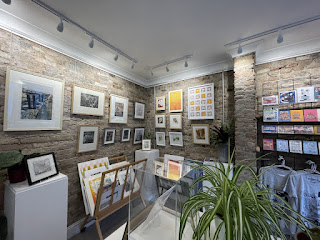York Art Gallery: Exhibition “Pictures of the Floating
World: Japanese Ukiyo-e Prints”
Overview
“Ukiyo-e translates as “pictures of the floating world” and refers
to the transitory nature of life. Works by prominent Ukiyo-e artists, such as
Utagawa Hiroshige, highlight the significant impact of Japanese art on the
western world during the 18th and 19th century. Interspersed
in between the prints are selected paintings from the galleries main
collection, the curator seeking out works which have a Japanese influence. The
key topics are well explained and the
prints hung in low light to preserve their fragile colours.
Landscape
The current review concentrates on the landscape aspect of
the exhibition. The scenes depicted – tea houses, rice fields, harbours,
waterfalls, and mountains, conjure up a unique sense of place.
Hiroshige’s Asakusa Rice-Fields and Torinomachi Festival
(below) illustrates the use of strong line both to frame the composition and
within the image. It is noticeable that, unlike in western art, no attempt has
been made by the artist to replicate the texture of the cat’s fur, or even to
add shading to the animal. Mount Fugi features in the background and is treated
in a similar way. A small number of bright colours, blue, orange/peach, and
green, bring life to the image.
Utagawa Hiroshige(1797-1858) Asakusa Rice-Fields and Torinomachi Festival, from the series ”One Hundred Famous Views of Edo”, Part 4:Winter
1857 Woodblock print
Exploring how Western artists were inspired by Japanese use
of line and colour, the gallery displayed Wolmark’s Hampstead
Old Power Station (above). Wolmark became influenced by the colour
palette and style of the Post-Impressionists, who in turn, had adopted
principles from Japanese art. We can see Wolmark’s daring use of blue, green
and pink and how he transforms the power station into flattened forms, with
little shading or use of perspective.
Utagawa Hiroshige (1797-1858) Kozuke Province: Evening View of Takanawa, from the series “Famous Places in the Eastern Capital” c. 1853 Woodblock print
Horoshige was inspired by the celebrated artist Hokusai, but
Hiroshige’s style is more “poetic” and employs subtle colour gradation, as can
be seen in Kozuke Province: Evening View of Takanawa
(above). Hiroshige’s subjects were not typical of early ukiyo-e, such as kabuki
actors and courtesans, and he came to specialise in landscapes. The Eastern
Capital (Edo, modern day Tokyo) was one of his favourite sites that he returned
to time and again.
In the late 19th century, it became popular for
western artists to adopt the subject matter of Japanese art. Prints of Mount
Fugi, and other mountains in Japan, were particularly well liked, and artists
flocked to the Bay of Naples, drawn by the striking power of Mount Vesuvius.
George Frederick Watts’ painting The Bay of Naples
bears similarities to landscapes by Hiroshige which depict popular seasonal
sights. These include the view across Lake Biwa, (see Descending Geese at Katata
below) and Mount Haruna under Snow (below).
Hiroshige specialised in sensitive depictions of mist, rain, snow, and moon
light to convey nature and the changing seasons. We see nature’s elements and
drama playing out in Watt’s painting.
George Frederick Watts, Bay of Naples, c. 1885-91, oil on
canvas
Utagawa Hiroshige(1797-1858) Descending Geese at Katata,
from the series “Eight Views of Omi”
1834-35 Woodblock print
Utagawa Hiroshige (1797-1858) Kozuke Province: Mount Haruna under Snow, from the series “Famous Places in the sixty-odd Provinces”
1853 Woodblock print
Conclusions
The exhibition told the story of Japanese Ukiyo-Prints and the
history of the period through a collection of prints with diverse subject
matter. Although I have focused my review on landscape, there is much for
everyone, including Japanese lifestyle, portraits, animals, and birds. The
gallery broadened the scope of the exhibition by exploring links with western
art, some features of which I have described above. The exhibition was a good
introduction into aspects of Japanese composition, colour, tone, and line which
will be interesting to explore in my own painting practice.
NOTES
The visit was a good example of how to exhibit images in low
lighting and the effect was very dramatic. The curator made good connections
with the work of British artists, which added another dimension to the
exhibition. My reflections on the Japanese use of perspective, line, colour and
tone made me think about their use in my own practice. I can connect with the
way the prints make use of flat surfaces and line. However, I think their use
of colour and tone was less helpful. There is little use of tone, and although
the palette works for the prints, I think that they are too “stark” for my
estuary/river paintings and for my landscape work generally. I find that
Wolmark’s Hampstead Old Power Station, for instance, is too pink/blue and the
greens of Watt’s Bay of Naples too “garish”. I am aiming for a more subtle
palette of soft browns and greens to reflect the local landscape. However, the strong
feelings of place which the works engendered, and their compositional elements are
very relevant to my practice and my thinking about broadening my horizons.
I think that the most important feature I can build on is
the Japanese use of space and flat surfaces. I already leave areas of blank
canvas, and this exhibition reinforced the impact empty spaces can have. As I
build up my ideas the spaces can be used to fill voids. The viewer can rest and
gaze, and introduce their own thoughts into the gaps, or be guided by my ideas,
such as a piece of poetry or a video/sound recording which has inspired the
work.


































